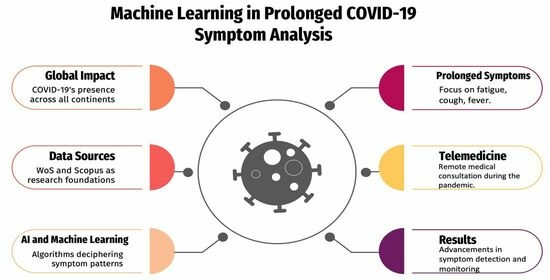Machine Learning Applied to the Analysis of Prolonged COVID Symptoms: An Analytical Review
Abstract
1. Introduction
2. Materials and Methods
2.1. Scientometric Analysis
2.2. Tree of Science (ToS)
3. Results
3.1. Scientific Analysis of Annual Production
3.2. Network of Countries
3.3. Journal Analysis
3.4. Analysis by Author
4. Tree of Science
4.1. Root
4.2. Trunk
4.3. Branch 1: Predictive Models and Clinical Prognostics in Pandemics and Their Post-Pandemic Effect
4.4. Branch 2: Mental Health and Psychosocial Responses to the Pandemic and Their Post-Pandemic Impact
4.5. Branch 3: Innovations in Telehealth and Psychiatric Care during and after the Pandemic
5. Discussions
6. Conclusions
Author Contributions
Funding
Institutional Review Board Statement
Informed Consent Statement
Data Availability Statement
Conflicts of Interest
References
- Monaghesh, E.; Hajizadeh, A. The role of telehealth during COVID-19 outbreak: A systematic review based on current evidence. BMC Public Health 2020, 20, 1193. [Google Scholar] [CrossRef] [PubMed]
- Zhou, X.; Snoswell, C.L.; Harding, L.E.; Bambling, M.; Edirippulige, S.; Bai, X.; Smith, A.C. The role of telehealth in reducing the mental health burden of COVID-19. Telemed. e-Health 2020, 26, 377–379. [Google Scholar] [CrossRef] [PubMed]
- Goodman-Casanova, J.; Dura-Perez, E.; Guzman-Parra, J.; Cuesta-Vargas, A.; Mayoral-Cleries, F. Telehealth home support during COVID-19 confinement for community-dwelling older adults with mild cognitive impairment or mild dementia: A survey study. J. Med. Internet Res. 2020, 22, 19434. [Google Scholar] [CrossRef] [PubMed]
- Garfan, S.; Alamoodi, A.H.; Zaidan, B.B.; Al-Zobbi, M.; Hamid, R.A.; Alwan, J.K.; Ibraheem, Y.Y.; Eman, T.; Jumaah, F.M.; Albahri, O.S.; et al. Telehealth utilization during the COVID-19 pandemic: A systematic review. Comput. Biol. Med. 2021, 138, 104878. [Google Scholar] [CrossRef] [PubMed]
- Alballa, N.; Al-Turaiki, I. Machine learning approaches in COVID-19 diagnosis, mortality, and severity risk prediction: A review. Inform. Med. Unlocked 2021, 24, 100564. [Google Scholar] [CrossRef] [PubMed]
- Chowdhury, D.; Hope, K.D.; Arthur, L.C.; Weinberger, S.M.; Ronai, C.; Johnson, J.N.; Snyder, C.S. Telehealth for pediatric cardiology practitioners in the time of COVID-19. Pediatr. Cardiol. 2020, 41, 1081–1091. [Google Scholar] [CrossRef] [PubMed]
- Moral-Munoz, J.; Herrera-Viedma, E.; Santisteban-Espejo, A.; Cobo, M. Software tools for conducting bibliometric analysis in science: An up-to-date review. Prof. Inf. 2020, 29, 3. [Google Scholar] [CrossRef]
- Aria, M.; Cuccurullo, C. Bibliometrix: An r-tool for comprehensive science mapping analysis. J. Informetr. 2017, 11, 959–975. [Google Scholar] [CrossRef]
- Grisales, A.; Robledo, S.; Zuluaga, M. Topic modeling: Perspectives from a literature review. IEEE Access 2023, 11, 4066–4078. [Google Scholar] [CrossRef]
- Robledo, S.; Duque, P.; Aguirre, A. Word of mouth marketing: A scientometric analysis. J. Sci. Res. 2023, 11, 436–446. [Google Scholar] [CrossRef]
- Valencia-Hernández, D.S.; Robledo, S.; Pinilla, R.; Duque-Méndez, N.D.; Olivar-Tost, G. SAP algorithm for citation analysis: An improvement to tree of science. Ing. E Investig. 2020, 40, 45–49. [Google Scholar] [CrossRef]
- Mingers, J.; Leydesdorff, L. A review of theory and practice in scientometrics. Eur. J. Oper. Res 2015, 246, 1–19. [Google Scholar] [CrossRef]
- Robledo, S.; Aguirre, A.; Hughes, M.; Eggers, F. “hasta la vista baby”—Will machine learning terminate human literature reviews in entrepreneurship? J. Small Bus. Manag. 2021, 61, 1314–1343. [Google Scholar] [CrossRef]
- Hurtado-Marín, V.; Agudelo-Giraldo, J.; Robledo, S.; Restrepo-Parra, E. Analysis of dynamic networks based on the ising model for the case of study of co-authorship of scientific articles. Sci. Rep. 2021, 11, 5721. [Google Scholar] [CrossRef] [PubMed]
- Do Carmo, G.; Felizardo, L.; de Castro Alcântara, V.; da Silva, C.; do Prado, J. The impact of jürgen habermas’s scientific production: A scientometric review. Scientometrics 2023, 128, 1853–1875. [Google Scholar] [CrossRef] [PubMed]
- Zuluaga, M.; Robledo, S.; Arbelaez-Echeverri, O.; Osorio-Zuluaga, G.; Duque-Méndez, N. Tree of science—Tos: A web-based tool for scientific literature recommendation. search less, research more issues. Issues Sci. Technol. Libr. 2022, 100. [Google Scholar] [CrossRef]
- Robledo, S. Tree of science with scopus: A shiny application. Librariansh 2022, 100. [Google Scholar] [CrossRef]
- Choi, N.; DiNitto, D.; Marti, C.; Choi, B. Telehealth use among older adults during COVID-19: Associations with sociodemographic and health characteristics, technology device ownership, and technology learning. J. Appl. Gerontol. 2022, 41, 600–609. [Google Scholar] [CrossRef] [PubMed]
- Barrera-Rubaceti, N.; Robledo-Giraldo, S.; Zarela-Sepulveda, M. Una revisión bibliográfica del fintech y sus principales subáreas de estudio. Econ. CUC 2021, 43, 83–100. [Google Scholar] [CrossRef]
- Marín-Rodríguez, N.; González-Ruiz, J.; Botero, S. A wavelet analysis of the dynamic connectedness among oil prices, green bonds, and CO2 emissions. Risks 2023, 11, 15. [Google Scholar] [CrossRef]
- Santovena-Casal, S.; Gil-Quintana, J.; Javier, H. Microteaching networks in higher education. Interact. Technol. Smart Educ. 2024, 21, 149–167. [Google Scholar] [CrossRef]
- Torres, G.; Robledo, S.; Berrío, S. Orientación al mercado: Importancia, evolución y enfoques emergentes usando análisis cienciométrico. Criteriolibre 2021, 19, 326–340. [Google Scholar] [CrossRef]
- Hatmal MM, M.; Al-Hatamleh, M.A.; Olaimat, A.N.; Hatmal, M.; Alhaj-Qasem, D.M.; Olaimat, T.M.; Mohamud, R. Side effects and perceptions following COVID-19 vaccination in jordan: A randomized, cross-sectional study implementing machine learning for predicting severity of side effects. Vaccines 2021, 9, 556. [Google Scholar] [CrossRef] [PubMed]
- Aziz, A.; Zork, N.; Aubey, J.J.; Baptiste, C.D.; D’Alton, M.E.; Emeruwa, U.N.; Fuchs, K.M.; Goffman, D.; Gyamfi-Bannerman, C.; Haythe, J.H.; et al. Telehealth for high-risk pregnancies in the setting of the COVID-19 pandemic. Am. J. Perinatol. 2020, 37, 800–808. [Google Scholar] [CrossRef]
- Khattar, A.; Jain, P.; Quadri, S. Effects of the disastrous pandemic COVID 19 on learning styles, activities and mental health of young indian students-a machine learning approach. In Proceedings of the 2020 4th International Conference on Intelligent Computing Control Systems (ICICCS), Madurai, India, 13–15 May 2020; pp. 1190–1195. [Google Scholar] [CrossRef]
- Guan, X.; Zhang, B.; Fu, M.; Li, M.; Yuan, X.; Zhu, Y.; Peng, J.; Guo, H.; Lu, Y. Clinical and inflammatory features-based machine learning model for fatal risk prediction of hospitalized COVID-19 patients: Results from a retrospective cohort study. Ann. Med. 2021, 53, 257–266. [Google Scholar] [CrossRef] [PubMed]
- Xue, J.; Chen, J.; Hu, R.; Chen, C.; Zheng, C.; Su, Y.; Zhu, T. Twitter discussions and emotions about the COVID-19 pandemic: Machine learning approach. J. Med. Internet Res. 2020, 22, 20550. [Google Scholar] [CrossRef] [PubMed]
- Torous, J.; Wykes, T. Opportunities from the coronavirus disease 2019 pandemic for transforming psychiatric care with telehealth. JAMA Psychiatry 2020, 77, 1205–1206. [Google Scholar] [CrossRef] [PubMed]
- Flesia, L.; Monaro, M.; Mazza, C.; Fietta, V.; Colicino, E.; Segatto, B.; Roma, P. Predicting perceived stress related to the COVID-19 outbreak through stable psychological traits and machine learning models. J. Clin. Med. 2020, 9, 3350. [Google Scholar] [CrossRef]
- Alessi, J.; de Oliveira, G.B.; Franco, D.W.; Becker, A.S.; Knijnik, C.P.; Kobe, G.L.; Amaral, B.B.; Brito, A.; Schaan, B.D.; Telo, G.H. Telehealth strategy to mitigate the negative psychological impact of the COVID-19 pandemic on type 2 diabetes: A randomized controlled trial. Acta Diabetol. 2021, 58, 899–909. [Google Scholar] [CrossRef]
- Montoya, M.I.; Kogan, C.S.; Rebello, T.J.; Sadowska, K.; Garcia-Pacheco, J.A.; Khoury, B.; Kulygina, M.; Matsumoto, C.; Robles, R.; Huang, J.; et al. An international survey examining the impact of the COVID-19 pandemic on telehealth use among mental health professionals. J. Psychiatr. Res. 2022, 148, 188–196. [Google Scholar] [CrossRef]
- Isautier, J.M.; Copp, T.; Ayre, J.; Cvejic, E.; Meyerowitz-Katz, G.; Batcup, C.; Bonner, C.; Dodd, R.; Nickel, B.; Pickels, K.; et al. People’s experiences and satisfaction with telehealth during the COVID-19 pandemic in australia: Cross-sectional survey study. J. Med. Internet Res. 2020, 22, 24531. [Google Scholar] [CrossRef] [PubMed]
- Andersen, J.A.; Rowland, B.; Gloster, E.; McElfish, P.A. Telehealth utilization during COVID-19 among people with diagnosed mental health conditions. Telemed. e-Health 2022, 28, 743–746. [Google Scholar] [CrossRef] [PubMed]
- Cheon, S.; Methiyothin, T.; Ahn, I. Analysis of COVID-19 vaccine adverse event using language model and unsupervised machine learning. PLoS ONE 2023, 18, 282119. [Google Scholar] [CrossRef] [PubMed]
- Werkmeister, B.; Haase, A.; Fleming, T.; Officer, T. Experiences of the COVID-19 lockdown and telehealth in aotearoa new zealand: Lessons and insights from mental health clinicians. Int. J. Environ. Res. Public Health 2023, 20, 4791. [Google Scholar] [CrossRef] [PubMed]
- An, C.; Lim, H.; Kim, D.W.; Chang, J.H.; Choi, Y.J.; Kim, S.W. Machine learning prediction for mortality of patients diagnosed with COVID-19: A nationwide korean cohort study. Sci. Rep. 2020, 10, 18716. [Google Scholar] [CrossRef] [PubMed]
- Lynch, D.; Medalia, A.; Saperstein, A. The design, implementation, and acceptability of a telehealth comprehensive recovery service for people with complex psychosis living in nyc during the COVID-19 crisis. Front. Psychiatry 2020, 11, 581149. [Google Scholar] [CrossRef] [PubMed]
- Abraham, H.N.; Opara, I.N.; Dwaihy, R.L.; Acuff, C.; Brauer, B.; Nabaty, R.; Levine, D.L. Engaging third-year medical students on their internal medicine clerkship in telehealth during COVID-19. Cureus 2020, 12, e8791. [Google Scholar] [CrossRef] [PubMed]
- Fatima, A.; Shahzad, T.; Abbas, S.; Rehman, A.; Saeed, Y.; Alharbi, M.; Khan, M.; Ouahada, K. COVID-19 detection mechanism in vehicles using a deep extreme machine learning approach. Diagnostics 2023, 13, 270. [Google Scholar] [CrossRef] [PubMed]
- Chapman, S.B.; Fratantoni, J.M.; Robertson, I.H.; D’Esposito, M.; Ling, G.S.; Zientz, J.; Vernon, S.; Venza, E.; Cook, L.; Tate, A.; et al. A novel brainhealth index prototype improved by telehealth-delivered training during COVID-19. Front. Public Health 2021, 9, 641754. [Google Scholar] [CrossRef]
- Callejon-Leblic, M.A.; Moreno-Luna, R.; Del Cuvillo, A.; Reyes-Tejero, I.M.; Garcia-Villaran, M.A.; Santos-Peña, M.; Maza-Solano, J.; Martín-Jimenez, D.; Palacios-Garcia, J.M.; Fernandez-Velez, C.; et al. Loss of smell and taste can accurately predict COVID-19 infection: A machine-learning approach. J. Clin. Med. 2021, 10, 570. [Google Scholar] [CrossRef]
- Mahdavi, M.; Choubdar, H.; Zabeh, E.; Rieder, M.; Safavi-Naeini, S.; Jobbagy, Z.; Ghorbani, A.; Abedini, A.; Kiani, A.; Khanlarzadeh, V.; et al. A machine learning based exploration of COVID-19 mortality risk. PLoS ONE 2021, 16, 252384. [Google Scholar] [CrossRef]
- Keshvardoost, S.; Bahaadinbeigy, K.; Fatehi, F. Role of telehealth in the management of COVID-19: Lessons learned from previous sars, mers, and ebola outbreaks. Telemed. e-Health 2020, 26, 850–852. [Google Scholar] [CrossRef]
- Peng, Y.; Li, C.; Rong, Y.; Pang, C.P.; Chen, X.; Chen, H. Real-time prediction of the daily incidence of COVID-19 in 215 countries territories using machine learning: Model development validation. J. Med. Internet Res. 2021, 23, 24285. [Google Scholar] [CrossRef] [PubMed]
- Joshi, S.; Ghosh, A.; Shukla, S. Machine learning model for depression prediction during COVID-19 pandemic. In Proceedings of the 2022 IEEE International Conference on Distributed Computing and Electrical Circuits and Electronics (ICDCECE), Ballari, India, 23–24 April 2022; pp. 1–5. [Google Scholar] [CrossRef]
- Liu, Y.; Xie, Y.-N.; Li, W.-G.; He, X.; He, H.-G.; Chen, L.-B.; Shen, Q. A machine learning-based risk prediction model for post-traumatic stress disorder during the COVID-19 pandemic. Medicina 2022, 58, 1704. [Google Scholar] [CrossRef] [PubMed]
- Reay, R.; Looi, J.; Keightley, P. Telehealth mental health services during COVID-19: Summary of evidence and clinical practice. Australas. Psychiatry 2020, 28, 514–516. [Google Scholar] [CrossRef]
- Wang, Y.; Wu, P.; Liu, X.; Li, S.; Zhu, T.; Zhao, N. Subjective well-being of chinese sina weibo users in residential lockdown during the COVID-19 pandemic: Machine learning analysis. J. Med. Internet Res. 2020, 22, 24775. [Google Scholar] [CrossRef] [PubMed]
- Zhao, Y.; Zhang, R.; Zhong, Y.; Wang, J.; Weng, Z.; Luo, H.; Chen, C. Statistical analysis and machine learning prediction of disease outcomes for COVID-19 and pneumonia patients. Front. Cell. Infect. Microbiol. 2022, 12, 838749. [Google Scholar] [CrossRef] [PubMed]
- Ahamad, M.M.; Aktar, S.; Rashed-Al-Mahfuz, M.; Uddin, S.; Liò, P.; Xu, H.; Summers, M.A.; Quinn, J.M.W.; Moni, M.A. A machine learning model to identify early-stage symptoms of sars-cov-2 infected patients. Expert. Syst. Appl. 2020, 160, 113661. [Google Scholar] [CrossRef]
- Reay, R.; Kisely, S.; Looi, J. Better access: Substantial shift to telehealth for allied mental health services during COVID-19 in australia. Aust. Health Rev. 2021, 45, 675–682. [Google Scholar] [CrossRef]
- Franco, D.W.; Alessi, J.; de Carvalho, T.R.; Kobe, G.L.; Oliveira, G.B.; Knijnik, C.P.; Amaral, B.; Becker, A.S.; Schaan, B.C.; Telo, G.H. The impact of a telehealth intervention on the metabolic profile of diabetes mellitus patients during the COVID-19 pandemic-a randomized clinical trial. Prim. Care Diabetes 2022, 16, 745–752. [Google Scholar] [CrossRef]
- Sarveswaran, G.; Rangamani, S.; Ghosh, A.; Bhansali, A.; Dharmalingam, M.; Unnikrishnan, A.G.; Vikram, N.K.; Mathur, P.; Misra, A. Management of diabetes mellitus through teleconsultation during COVID-19 and similar scenarios-guidelines from indian council of medical research (icmr) expert group. Diabetes Metab. Syndr. Clin. Res. Rev. 2021, 15, 102242. [Google Scholar] [CrossRef] [PubMed]
- Robotti, C.; Costantini, G.; Saggio, G.; Cesarini, V.; Calastri, A.; Maiorano, E.; Piloni Perrone, T.; Sabatini, U.; Ferretti, V.V.; Benazzo, M.; et al. Machine learning-based voice assessment for the detection of positive recovered COVID-19 patients. J. Voice 2021, 38, 796.e1–796.e13. [Google Scholar] [CrossRef] [PubMed]
- Looi, J.C.; Allison, S.; Bastiampillai, T.; Pring, W.; Reay, R.; Kisely, S.R. Increased Australian outpatient private practice psychiatric care during the COVID-19 pandemic: Usage of new MBS-telehealth item and face-to-face psychiatrist office-based services in Quarter 3, 2020. Australas. Psychiatry 2021, 29, 194–199. [Google Scholar] [CrossRef] [PubMed]
- Spitzer, R.; Kroenke, K.; Williams, J.; Löwe, B. A brief measure for assessing generalized anxiety disorder: The gad-7. Arch. Intern. Med. 2006, 166, 1092–1097. [Google Scholar] [CrossRef] [PubMed]
- Brooks, S.K.; Webster, R.K.; Smith, L.E.; Woodland, L.; Wessely, S.; Greenberg, N.; Rubin, G.J. The psychological impact of quarantine and how to reduce it: Rapid review of the evidence. Lancet 2020, 395, 912–920. [Google Scholar] [CrossRef] [PubMed]
- Kroenke, K.; Spitzer, R.; Williams, J. The phq-9: Validity of a brief depression severity measure. J. Gen. Intern. Med. 2001, 16, 606–613. [Google Scholar] [CrossRef]
- Prout, T.A.; Zilcha-Mano, S.; Aafjes-van Doorn, K.; Békés, V.; Christman-Cohen, I.; Whistler, K.; Kui, T.; Di Giuseppe, M. Identifying predictors of psychological distress during COVID-19: A machine learning approach. Front. Psychol. 2020, 11, 586202. [Google Scholar] [CrossRef]
- Roma, P.; Monaro, M.; Muzi, L.; Colasanti, M.; Ricci, E.; Biondi, S.; Napoli, C.; Ferracuti, S.; Mazza, C. How to improve compliance with protective health measures during the COVID-19 outbreak: Testing a moderated mediation model and machine learning algorithms. Int. J. Environ. Res. Public Health 2020, 17, 7252. [Google Scholar] [CrossRef]
- Eder, S.J.; Steyrl, D.; Stefanczyk, M.M.; Pieniak, M.; Martínez Molina, J.; Pešout, O.; Binter, J.; Smela, P.; Scharnowski, F.; Nicholson, A.A. Predicting fear and perceived health during the COVID-19 pandemic using machine learning: A cross-national longitudinal study. PLoS ONE 2021, 16, 247997. [Google Scholar] [CrossRef]
- Békés, V.; Aafjes-van Doorn, K.; Zilcha-Mano, S.; Prout, T.; Hoffman, L. Psychotherapists’ acceptance of telepsy- chotherapy during the COVID-19 pandemic: A machine learning approach. Clin. Psychol. Psychother. 2021, 28, 1403–1415. [Google Scholar] [CrossRef]
- Lee, B.H.; Lee, K.S.; Kim, H.I.; Jung, J.S.; Shin, H.J.; Park, J.H.; Hong, S.C.; Ahn, K.H. Blood transfusion, all-cause mortality and hospitalization period in COVID-19 patients: Machine learning analysis of national health insurance claims data. Diagnostics 2022, 12, 2970. [Google Scholar] [CrossRef]
- Pathak, T.; Athavale, H.; Pathak, A.; Athavale, S.; Pathak, A. Sentiments evoked by who public health posts during the COVID-19 pandemic: A neural network-based machine learning analysis. Cureus 2021, 13, e19141. [Google Scholar] [CrossRef] [PubMed]
- Chen, C.-C.; Chang, C.-K.; Chiu, C.-C.; Yang, T.-Y.; Hao, W.-R.; Lin, C.-H.; Fang, Y.-A.; Jian, W.; Hsu, M.-H.; Yang, T.-L.; et al. Machine learning analyses revealed distinct arterial pulse variability according to side effects of pfizer-biontech COVID-19 vaccine (bnt162b2). J. Clin. Med. 2022, 11, 6119. [Google Scholar] [CrossRef] [PubMed]
- Bakkeli, N. Predicting COVID-19 exposure risk perception using machine learning. BMC Public Health 2023, 23, 1377. [Google Scholar] [CrossRef] [PubMed]
- Rezapour, M.; Niazi, M.; Gurcan, M. Machine learning-based analytics of the impact of the COVID-19 pandemic on alcohol consumption habit changes among united states healthcare workers. Sci. Rep. 2023, 13, 6003. [Google Scholar] [CrossRef] [PubMed]
- Jamshidi, E.; Asgary, A.; Tavakoli, N.; Zali, A.; Dastan, F.; Daaee, A.; Badakhshan, M.; Esmaily, H.; Jamaldini, S.H.; Mansouri, N.; et al. Symptom prediction and mortality risk calculation for COVID-19 using machine learning. Front. Artif. Intell. 2021, 4, 673527. [Google Scholar] [CrossRef] [PubMed]
- Enevoldsen, K.C.; Danielsen, A.A.; Rohde, C.; Jefsen, O.H.; Nielbo, K.L.; Østergaard, S.D. Monitoring of COVID-19 pandemic-related psychopathology using machine learning. Acta Neuropsychiatr. 2022, 34, 148–152. [Google Scholar] [CrossRef] [PubMed]
- Santos, D.; Perkusich, A. Classification models for COVID-19 test prioritization in brazil: Machine learning approach. J. Med. Internet Res. 2021, 23, 27293. [Google Scholar] [CrossRef]
- Ariza-Colpas, P.; Morales-Ortega, R.; Piñeres-Melo, M.; De la Hoz-Franco, E.; Echeverri-Ocampo, I.; Salas-Navarro, K. Parkinson disease analysis using supervised and unsupervised techniques. In Advances in Swarm Intelligence, Proceedings of the 10th International Conference, ICSI 2019, Chiang Mai, Thailand, 26–30 July 2019; Proceedings, Part II 10; Springer International Publishing: Cham, Switzerland, 2019; pp. 191–199. [Google Scholar]
- Echeverri-Ocampo, I.; Urina-Triana, M.; Ariza, P.P.; Mantilla, M. El trabajo colaborativo entre ingenieros y personal de la salud para el desarrollo de proyectos en salud digital: Una visión al futuro para lograr tener éxito. Arch. Venez. Farmacol. Y Ter. 2018, 37, 400–405. [Google Scholar]
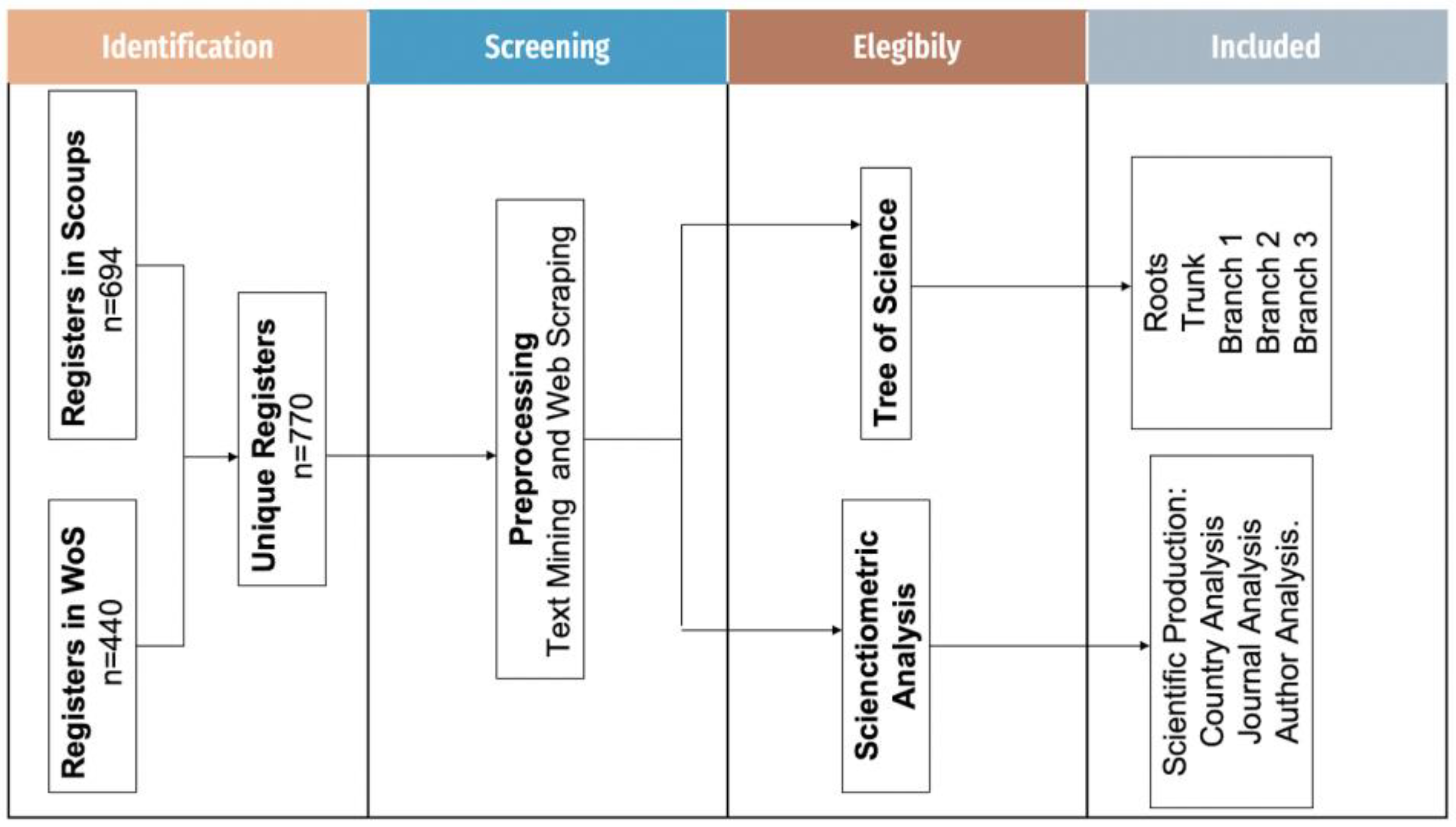


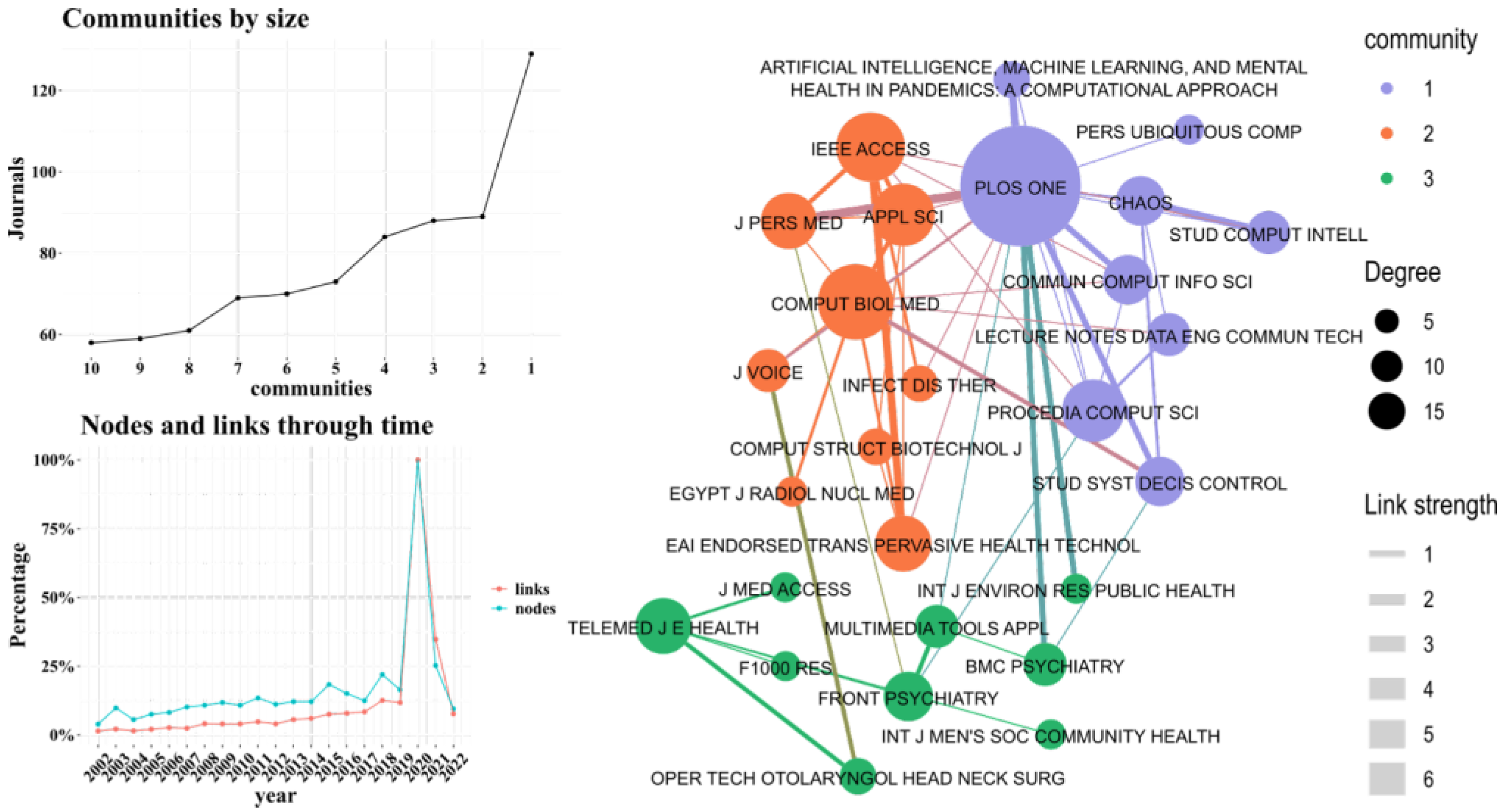
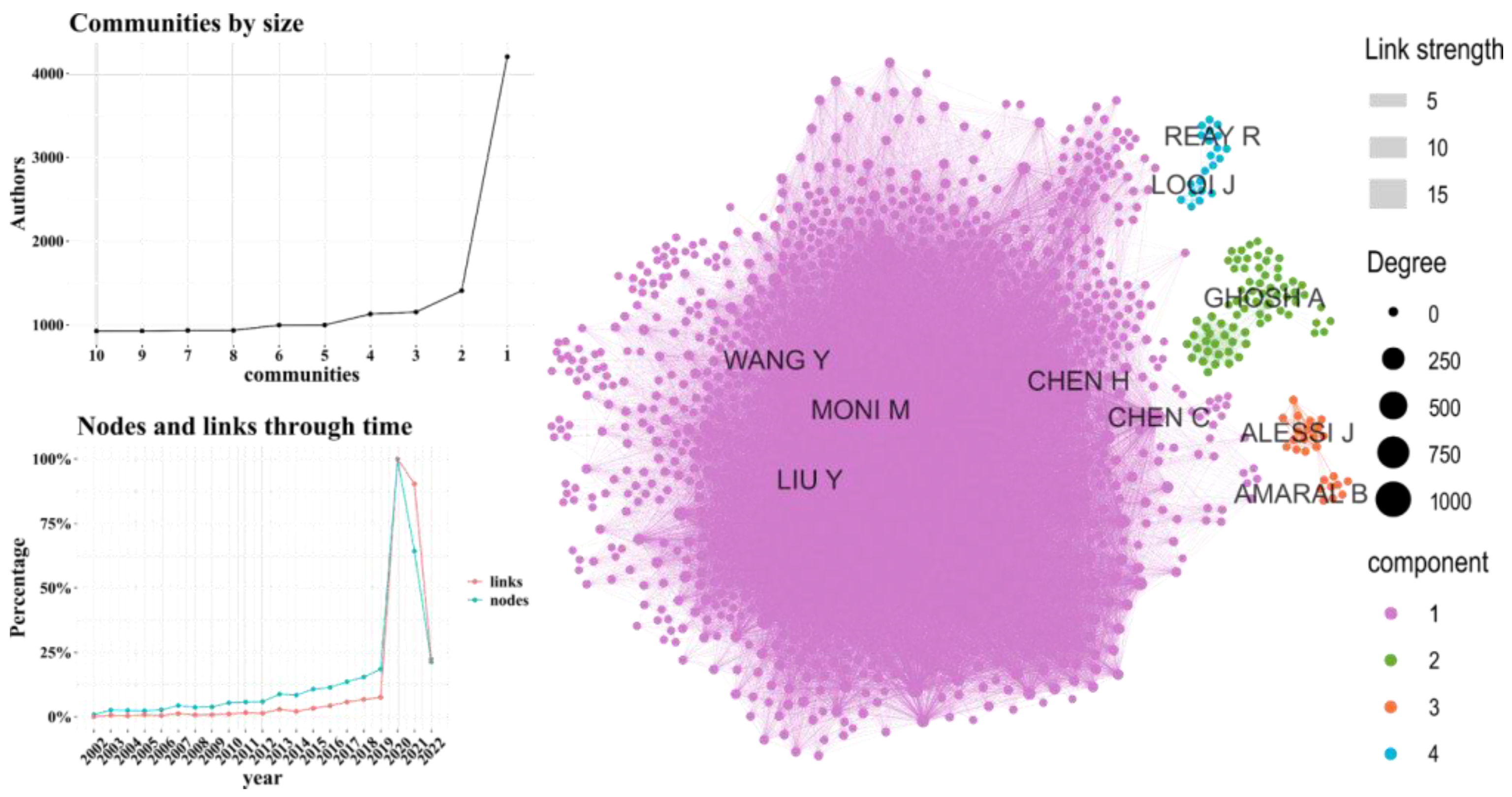
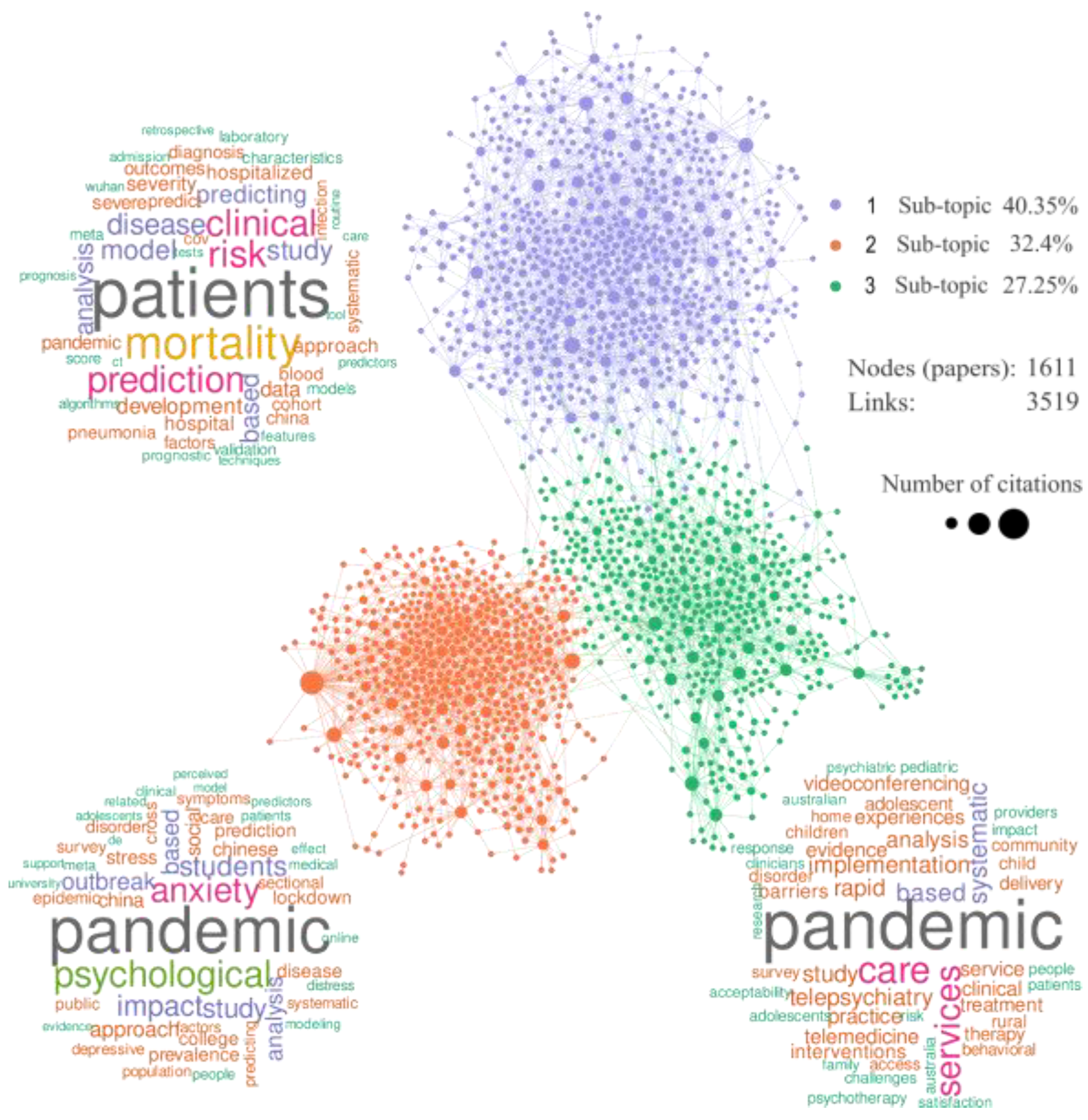
| Parameter | WoS | Scopus |
|---|---|---|
| Range | 2019–2024 | |
| Date | December 2024 | |
| Type of Document | Paper, book, chapter, conference proceedings | |
| Words | COVID-19 OR COVID OR SARS-CoV-2 OR coronavirus OR 2019-ncov | |
| Results | 440 | 694 |
| Total (WoS + Scopus) | 1134 | |
| Country | Production | Citation | Q1 | Q2 | Q3 | Q4 | ||
|---|---|---|---|---|---|---|---|---|
| USA | 315 | 33.65% | 3551 | 28.38% | 153 | 47 | 14 | 2 |
| India | 81 | 8.65% | 477 | 3.81% | 8 | 3 | 7 | 10 |
| Australia | 69 | 7.37% | 1325 | 10.59% | 24 | 18 | 8 | 3 |
| China | 41 | 4.38% | 1305 | 10.43% | 24 | 5 | 1 | 0 |
| Canada | 36 | 3.85% | 382 | 3.05% | 16 | 4 | 0 | 1 |
| United Kingdom | 31 | 3.31% | 293 | 2.34% | 15 | 2 | 0 | 3 |
| Italy | 29 | 3.1% | 536 | 4.28% | 14 | 8 | 3 | 0 |
| Iran | 28 | 2.99% | 834 | 6.67% | 5 | 6 | 2 | 4 |
| Brazil | 27 | 2.88% | 125 | 1% | 11 | 6 | 3 | 1 |
| Spain | 20 | 2.14% | 355 | 2.84% | 12 | 3 | 0 | 0 |
| Journal | WoS | Scopus | Impact Factor | H-Index | Quartile |
|---|---|---|---|---|---|
| Journal of Medical Internet Research | 12 | 18 | 1.99 | 178 | Q1 |
| Telemedicine and E-Health | 14 | 14 | 1.24 | 87 | Q1 |
| Plos One | 8 | 14 | 0.89 | 404 | Q1 |
| International Journal of Environmental Research and Public Health | 7 | 9 | 0.83 | 167 | Q2 |
| Scientific Reports | 9 | 8 | 0.97 | 282 | Q1 |
| Frontiers in Psychiatry | 8 | 9 | 1.22 | 96 | Q1 |
| Cureus Journal of Medical Science | 7 | 0 | - | - | - |
| Diagnostics | 4 | 7 | 0.67 | 52 | Q2 |
| Frontiers in Public Health | 7 | 5 | 1.13 | 80 | Q1 |
| Journal of Clinical Medicine | 4 | 7 | 0.94 | 95 | Q1 |
| No | Researcher | Total Articles | Scopus-Index | Affiliation |
|---|---|---|---|---|
| 1 | Chen H. [44] | 6 | 35 | Shantou University, Shantou, China |
| 2 | Ghosh A. [45] | 6 | 1 | Christ University, Bengaluru, Bengaluru, India |
| 3 | Liu Y. [46] | 6 | 2 | School Of Medicine, Xiamen, China |
| 4 | Looi J. [47] | 6 | 24 | The Australian National University, Canberra, Australia |
| 5 | Wang Y. [48] | 6 | 5 | Universidad De La Academia China De Ciencias, Beijing, China |
| 6 | Chen C. [49] | 5 | 11 | College Of Medicine, Taipei, Taiwan |
| 7 | Moni M.A. [50] | 5 | 40 | The University Of Queensland, Brisbane, Australia |
| 8 | Reay R. [51] | 5 | 12 | The Australian National University, Canberra, Australia |
| 9 | Alessi J. [52] | 4 | 6 | Universidade Federal Do Rio Grande Do Sul, Porto Alegre, Brazil |
| 10 | Amaral B. [53] | 4 | 3 | Pontifícia Universidade Católica Do Rio Grande Do Sul, Porto Alegre, Brazil |
Disclaimer/Publisher’s Note: The statements, opinions and data contained in all publications are solely those of the individual author(s) and contributor(s) and not of MDPI and/or the editor(s). MDPI and/or the editor(s) disclaim responsibility for any injury to people or property resulting from any ideas, methods, instructions or products referred to in the content. |
© 2024 by the authors. Licensee MDPI, Basel, Switzerland. This article is an open access article distributed under the terms and conditions of the Creative Commons Attribution (CC BY) license (https://creativecommons.org/licenses/by/4.0/).
Share and Cite
Ariza-Colpas, P.P.; Piñeres-Melo, M.A.; Urina-Triana, M.A.; Barceló-Martinez, E.; Barceló-Castellanos, C.; Roman, F. Machine Learning Applied to the Analysis of Prolonged COVID Symptoms: An Analytical Review. Informatics 2024, 11, 48. https://doi.org/10.3390/informatics11030048
Ariza-Colpas PP, Piñeres-Melo MA, Urina-Triana MA, Barceló-Martinez E, Barceló-Castellanos C, Roman F. Machine Learning Applied to the Analysis of Prolonged COVID Symptoms: An Analytical Review. Informatics. 2024; 11(3):48. https://doi.org/10.3390/informatics11030048
Chicago/Turabian StyleAriza-Colpas, Paola Patricia, Marlon Alberto Piñeres-Melo, Miguel Alberto Urina-Triana, Ernesto Barceló-Martinez, Camilo Barceló-Castellanos, and Fabian Roman. 2024. "Machine Learning Applied to the Analysis of Prolonged COVID Symptoms: An Analytical Review" Informatics 11, no. 3: 48. https://doi.org/10.3390/informatics11030048
APA StyleAriza-Colpas, P. P., Piñeres-Melo, M. A., Urina-Triana, M. A., Barceló-Martinez, E., Barceló-Castellanos, C., & Roman, F. (2024). Machine Learning Applied to the Analysis of Prolonged COVID Symptoms: An Analytical Review. Informatics, 11(3), 48. https://doi.org/10.3390/informatics11030048






